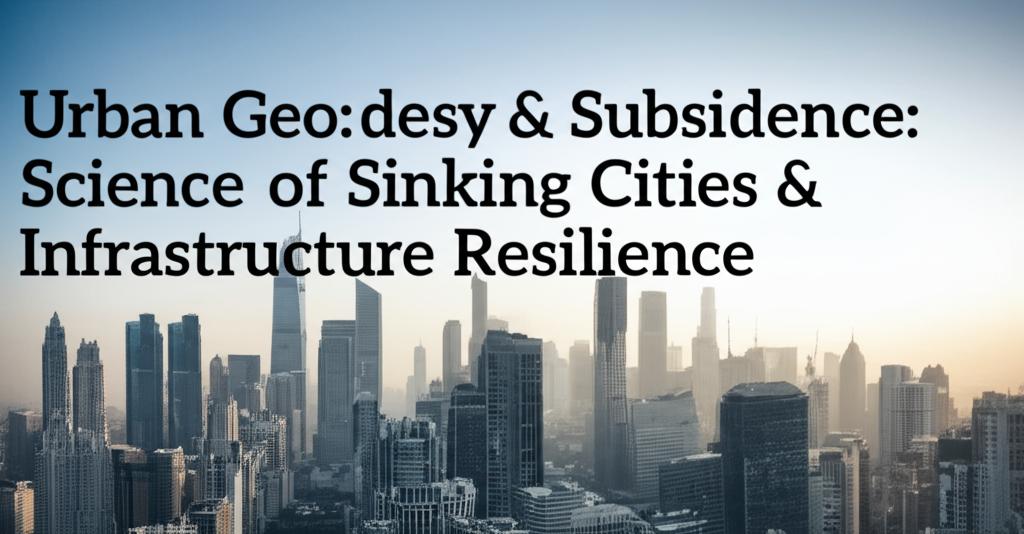The Silent Threat: Understanding Urban Subsidence and Building Resilient Infrastructure
Cities worldwide are facing a largely invisible yet significant threat: the ground beneath them is sinking. This phenomenon, known as land subsidence, poses a considerable risk to urban infrastructure, increasing vulnerability to events like flooding and causing direct damage to buildings, roads, and utility systems. Understanding the science behind why cities sink and developing strategies for infrastructure resilience is crucial for the future of our urban centers.
The Science of Sinking Cities: What is Urban Geodesy and Subsidence?
Urban geodesy plays a critical role in understanding and monitoring land subsidence. It involves precise measurement and monitoring of the ground surface, employing techniques such as:
- Interferometric Synthetic Aperture Radar (InSAR): This advanced remote sensing technique uses satellite radar imagery to detect ground deformation with millimeter-level precision over large areas. It allows for the creation of high-resolution subsidence maps, identifying areas of concern and tracking changes over time.
- Global Navigation Satellite Systems (GNSS), including GPS: By establishing networks of permanent ground stations, GNSS can measure changes in ground elevation with high accuracy, providing continuous data on subsidence rates at specific points.
- Leveling Surveys: This traditional geodetic technique involves precise measurement of height differences between benchmarks. While labor-intensive, it remains a valuable tool for local-scale monitoring.
- Airborne LiDAR (Light Detection and Ranging): This method uses laser pulses from aircraft to create detailed topographic maps. Repeated surveys can reveal changes in ground elevation and estimate subsidence.
Land subsidence can be caused by a combination of natural and anthropogenic (human-induced) factors:
- Natural Causes: These include tectonic activity, the natural compaction of sediments (especially soft alluvial soils common in coastal and riverine areas), and glacial isostatic adjustments.
- Human-Induced Causes: This is the primary driver of subsidence in many urban areas. The most significant factor is often the excessive extraction of groundwater. When large volumes of water are pumped from underground aquifers, the water pressure that helps support the overlying soil and rock layers decreases. This leads to the compaction of the aquifer system and the subsequent sinking of the land surface. Other human activities contributing to subsidence include the extraction of oil and gas, mining activities, and the sheer weight of urban development (load of constructions) on compressible soils.
The Far-Reaching Impacts of Urban Subsidence
The consequences of land subsidence are multifaceted and can be severe:
- Infrastructure Damage: Buildings, roads, bridges, pipelines, and drainage systems can crack, tilt, or collapse due to uneven ground settlement. This often leads to costly repairs and disruptions to essential services. The latent nature of this risk means infrastructure can be silently compromised over time, with damage only becoming evident when it is severe.
- Increased Flood Risk: As land sinks, especially in coastal cities or low-lying areas, the risk of flooding from rainfall, rivers, and storm surges dramatically increases. This is further exacerbated by rising sea levels due to climate change.
- Environmental Degradation: Subsidence can lead to saltwater intrusion into freshwater aquifers, particularly in coastal regions, impacting water quality. It can also alter natural drainage patterns and damage ecosystems.
- Economic Losses: The costs associated with repairing damaged infrastructure, mitigating flood risks, and addressing environmental impacts can be enormous. Subsidence can also negatively affect property values and economic activity in affected areas.
- Social Impacts: Subsidence can impact the quality of life for residents, affecting health and sanitation conditions, and in severe cases, leading to displacement.
Recent studies highlight the widespread nature of this issue. For instance, research published in May 2025 indicated that all 28 of the most populous cities in the United States are experiencing some degree of land sinking, primarily due to groundwater extraction. Houston was identified as the fastest-sinking city in this study, with some areas subsiding at rates exceeding 5 mm per year. Even seemingly small rates of subsidence, especially if uneven across an area, can lead to significant infrastructure damage.
Building Resilience: Strategies for Sinking Cities
Addressing urban subsidence requires a multi-pronged approach focused on mitigation and adaptation:
- Sustainable Groundwater Management: This is paramount. Cities must reduce their reliance on excessive groundwater extraction by:
Identifying and utilizing alternative water sources (e.g., purified surface water, desalinated seawater, rainwater harvesting).
Implementing water conservation measures and improving water infrastructure to reduce leaks.
Artificially recharging aquifers by injecting surface water or treated wastewater back into the ground to help restore groundwater levels.
- Enhanced Infrastructure Design and Reinforcement:
Constructing buildings and infrastructure designed to withstand some ground movement. This can include using materials and techniques that minimize the impact on vulnerable soils and building on stilts or with compensated foundations in high-risk areas.
Retrofitting existing vulnerable structures to improve their resilience.
- Improved Urban Planning and Land Use Management:
Integrating subsidence risk into urban planning policies and development C_CODEs.
Limiting development in high-risk subsidence zones.
Promoting "sponge city" concepts by increasing permeable surfaces (like permeable asphalt and green spaces) to allow rainwater to infiltrate the ground and recharge aquifers naturally.
- Advanced Monitoring and Early Warning Systems:
Continuously monitoring land subsidence using geodetic techniques like InSAR and GNSS to identify vulnerable areas and track changes over time. This data is crucial for proactive risk management.
- Collaboration and Awareness:
Fostering collaboration between governments, the private sector, research institutions, and communities to develop and implement effective solutions.
* Raising public awareness about the causes and impacts of land subsidence to encourage water conservation and support mitigation efforts.
- Protecting Coastal Areas: For coastal cities, building flood defenses like seawalls and levees, and restoring natural coastal habitats like mangroves and wetlands, can help mitigate the combined impacts of subsidence and sea-level rise.
The challenge of sinking cities is complex and requires urgent, sustained attention. By embracing scientific understanding, implementing innovative engineering solutions, and fostering collaborative action, cities can mitigate subsidence risks and build a more resilient and sustainable future for their inhabitants.

